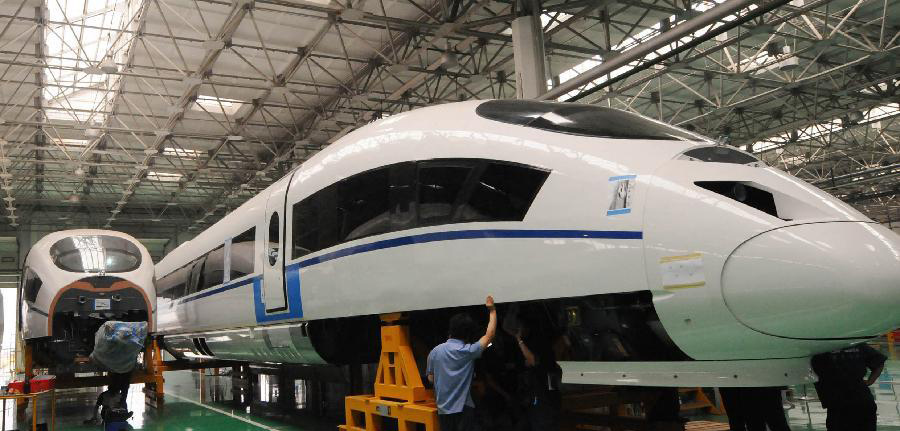Scholars: China should exploit its edge in high-end equipment

Pictured above is a production line for high-speed railway equipment. China has a good global reputation for high-end manufacturing in rail transportation and various other fields.
Recently, experts and scholars suggested drawing on the nation’s advantages in high-end equipment manufacturing to shore up the “Made in China 2025” plan, a 10-year roadmap designed to transform China into a world manufacturing power.
Li Minrong, chairman of the Zhongzhi Science and Technology Evaluation Center, pointed out three meanings of “high end”— standing at the cutting edge of research and development in multiple fields, being at the top of the chain in traditional and emerging industries, and producing products with high added value. These are indispensable elements for a country to ensure a favorable position in the global value chain, he said.
Through years of transformation and innovation, China has gained competitive advantages in high-end equipment manufacturing. Guo Zhouming, president of China Commercial Press, said that the Made in China 2025 strategy conforms to the trend of the new technological revolution.
Backbone and leading manufacturing enterprises have emerged that are keen to take advantage of the huge domestic market, and make breakthroughs in independent innovation and core technologies, Zhou said. Moreover, well-educated and skilled talent provides a guarantee for the sustainable development of high-end manufacturing in China.
In addition, Li pointed out progress in industrial restructuring. State-owned enterprises have taken on major R&D projects while private enterprises have achieved substantial development, he said. A strategic layout is taking shape with major high-end manufacturing industries concentrated in industrial bases, including the Mid-Southern Liaoning Zone, the Beijing-Tianjin-Tangshan industrial base, the Shanghai-Nanjing-Hangzhou industrial base and the Pearl River Delta.
Li added that high-end manufacturing in China has become more competitive internationally. The domestic industry has a good global reputation for producing equipment in various fields, such as rail transportation, conventional power generation, electric transmission and transformation, harbor handling and cementing.
The progress made by the Belt and Road initiative has opened new space for international cooperation in high-end manufacturing. Scholars said China should seize the opportunity to obtain a bigger share in the international market.
Guo suggested establishing a special fund and reducing taxes while encouraging large financial organizations to provide personalized services in order to enhance financing capacity of high-end manufacturing enterprises. It is also necessary to set up balanced industrial clusters to strengthen coordination between business groups, large enterprises, and small and medium-sized enterprises.
In addition, Zhou pointed out the significance of constructing a brand system. Enterprises need to develop core technologies, make high-quality products and provide better services, which will give them an edge in innovation instead of just price advantage.
Furthermore, he said that a property rights system is needed to protect high-end brands and patents. Enterprises should comply with international standards for quality safety and environmental protection to enhance the brand value of high-end Chinese manufacturing, he added.
